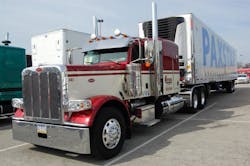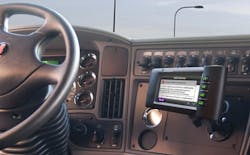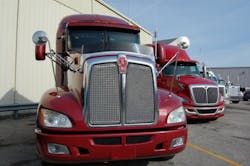Talking about the electronic logging device (ELD) mandate these days is like opening up Pandora’s Box – a lot of negatives come screaming out, with the lid slammed shut before “hope” gets a chance to escape.
In the eyes of many within trucking, the ELD mandate is nothing but a burden – a significant extra cost that can’t be recouped via “savings” such as by jettisoning pencil and paper recordkeeping.
[Thing is, truck drivers must still keep paper logbooks close at hand as part of the mandate as a backup. So they are not truly going away. But that is a topic for another day.]
This issue is taking on greater significance right now not only because there are two separate legislative efforts in Congress right now aimed at delaying the ELD mandate – neither of which is expected to succeed – but also because a significant number of trucking companies still haven’t complied with it.
Indeed, according to a recent survey we conducted, only 33.7% of the fleets we polled are currently “fully compliant” with the ELD mandate right now – and don’t forget, the mandate goes into effect Dec. 18 this year – while another 19.8% have a solution in hand and are in the process of implementing it.
That means just 53.5% of the fleets we’ve polled are ready for the rule, with the rest as-yet unprepared to comply with it. In fact, 11% of the fleets in our survey said they are NOT investigating how to comply with the mandate and thus won’t be ready when it goes into effect.
[We’ll be sharing more details from about our survey in the special ELD supplement we’re publishing in the September issue of Fleet Owner magazine.]
Again, though, one of the main reasons many motor carriers – large and small alike – are procrastinating on ELD adoption centers on the costs to do so.
For example, Ashley Cruz, a procurement research analyst with consulting firm IBISWorld recently addressed that point in a white paper entitled Easier, Safer and More Expensive: ELD Mandate to Increase Costs.
“The FMCSA [Federal Motor Carrier Safety Administration] insists that ELDs will save trucking companies a collective $1.6 billion per year by limiting paperwork costs and enhancing fuel efficiency,” Cruz wrote.
“However, most carriers and independent operators claim that the mandate will increase their compliance costs,” Cruz stressed. “For example, Omnitracs estimates that new devices will cost carriers between $199 and $2,200 per truck, plus a monthly service fee of $20 to $60 per truck.”
That quickly adds up, Cruz warned, especially for large fleets. For a motor carrier operating 10,000 trucks, for example, the ELD service fee alone amounts to between $2.4 million and $7.2 million annually, not including the one-time costs associated with procuring and installing the ELD devices, which must be hard-wired into a truck’s engine.
“Owner-operators, [who] already generate razor-thin profit margins, often do not have the capital to purchase a new device outright,” Cruz pointed out. “Many ELD providers are offering a financing program for their products, but owner-operators only require one ELD each, and thus do not meet the quantity threshold to be given financing options.”
Moreover, Cruz said as owner-operators are often subcontracted by larger trucking companies, they do not have enough pricing power to increase their rates to cover the higher costs, he explained.
“Those drivers fear that electronic devices will allow their contracting companies to exert more pressure and take advantage of independent drivers,” Cruz emphasized. “This dynamic will likely exacerbate tensions that already exist between these two groups over whether full-time owner-operators should receive employment status and benefits.”
Jeremy Feucht, a regulatory analyst with Truckstop.com, argued recently that all of this “tension” should open up an opportunity for truckers (big and little both) to raise their freight rates.
Feucht posits that the average cost to ELD users will be roughly $25 to $30 per truck per month, with that cost varying depending on the “functionality, bells, and whistles” of said device.
“You should plan to raise your asking price by at least 1% per mile,” he said, which, according to current dry van freight rates, this would equal out to about 18 cents more per mile.
“This would increase your rate-per-mile to $2.03 or $1,017.50 per-load, on average and give you enough margin not only to offset the cost of the service but also any equipment you may need to purchase, in addition to the cost of training yourself and your employees,” Feucht stressed.
Yet can motor carriers and owner-operators obtain freight rate increases to offset the cost of ELDs? That’s the million-dollar question, isn’t it?
John Larkin, managing director and head of transportation capital markets research for Stifel Capital Markets, believes we may be turning a corner at the very least where freight rates for truckers are concerned – though it’s been a VERY slow turning.
“If you think back to last July, a year ago, this spot market began to tighten a little bit then; historically within six months contract rates usually respond by going up as well but this time around that model kind of broke down,” he explained during a presentation at the Truckload Carriers Association (TCA) refrigerated division meeting back in mid July.
“Here we are 12 months after spot rates inflected and we’re not hearing a lot of shippers coming up to the bar with big time rate boosts,” he pointed out.
“Hopefully those are coming, no later than bid season in the first half of next year, but we just did a fairly comprehensive survey and are seeing a lot of contractual rate increases,” Larkin said. “Some carriers are getting some rate increases in some lanes; there’s always exceptions but know across the board increases are generally being granted. At least the rates aren’t going down any more, which is a good thing.”
That will be critical going forward as Larkin believes the point of no return has long been passed where the ELD mandate is concerned – despite ongoing efforts to derail it.
“There appears to be too much toothpaste out of the tube, as it were, to really put the toothpaste back in the tube,” he explained. “Come December 18th we’re going to be entering a new world. The reality is nobody knows what the impact is going to be because you can’t model individual behavior very well and you cannot get your arms around how each of the states is going to enforce ELD mandate.”
With that in mind, Larkin said the trucking and logistics industry will just have to “wait and see” what the final impact of the ELD rule will be.
“It could be as little as no impact; that’s the position that C.H. Robinson has, that the market always adjusts to these sorts of changes and people are blowing this too far out of proportion,” he noted.
“Then there are people who say, wait a minute here; it’s not just the reduced productivity of the carriers that are now cheating it’s also a good number of carriers who may not be able to operate economically without cheating,” Larkin pointed out. “I think what you have now is a lot of small carriers who have a natural cost disadvantage because they don’t have the purchasing economies and network efficiencies of a big carrier. They make it up by cheating; they drive too fast and too far every day.”
So if enforcement of the ELD mandate begins on or about Dec. 18 as expected and if the boom is lowered on those who don’t comply, Larkin suspects what has occurred over the years in the LTL sector will start to occur in the TL slice of the market: freight brokers and shippers will start dealing more with the larger motor carriers.
“The [big] carriers will figure out how to use the brokers to get better lane balance and to maximize their pricing and maximize the revenue puncture in more of a dynamic pricing than normal,” he said.
We’ll see if that prediction comes true.
About the Author
Sean Kilcarr
Editor in Chief
Sean Kilcarr is a former longtime FleetOwner senior editor who wrote for the publication from 2000 to 2018. He served as editor-in-chief from 2017 to 2018.




